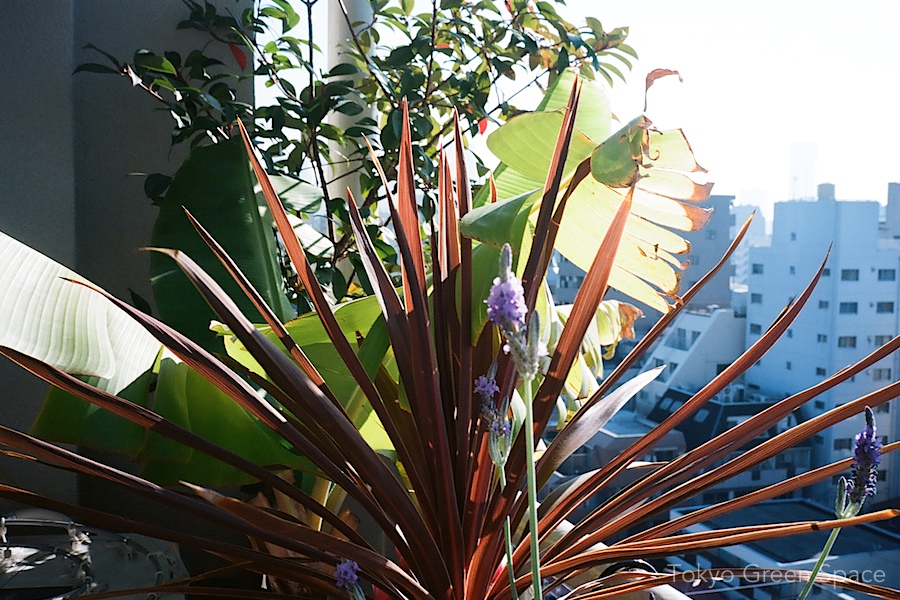
ベランダにあるこの四つの植物はそれぞれに別の色や形や起源があります。起源は、フランス、オーストラリア、フィリピン、東京です。
This balcony vignette includes contrasting colors and shapes with plants from France, Australia, Pilipinas, and Tokyo (lavender, formium, banana, and kanamemochi).
Frequently I hear from urban planners, professors, students, and green city people from around the world who want to share their projects or meet people in my network. I encourage them to create a guest blog post. Below is a French student project that turns urban or rural nature discovery into a video game. It sounds creative and fun! The makers will be at Tokyo’s Miraikan this week to talk about it. And, if you would like to share your project, please send in a guest blog post! [Editor]

Can nature be the playground of a video game? Interested in this idea, five students in digital design and production from Gobelins, l’école de l’image, Paris, worked for nine months on a common graduation project named úti (Icelandic for “outdoor”). By addressing the discovery of nature using a game, the team, composed of three graphic designers and two developers, wishes to approach a young audience.
The concept is simple: put in the shoes of a explorer, the player starts exploring the nature that surrounds him, be it a green space downtown, or a forest in the countryside.
The game is composed of a mobile application, which uses GPS to record the walking path and provide the player with contextual activities: discover nearby points of interest, identify tree species, take part in collaborative timelapse animations by taking photos…
Back home, the player can visualize the territory he explored and the species he identified, by connecting to his base camp on úti website.

úti will be showcased at the Digital Content Expo, in the Miraikan, from tomorrow to Sunday. You will be able to test the mobile application and meet the team at the “Futur en Seine” stand (1F).
They are looking for partners and investors, so if you are interested in supporting the project, please contact the team at contact@projet-uti.com
More info on the Digital Content Expo website: http://www.dcexpo.jp/en/programs/futurenseine/
Visit úti website for video demos: http://www.projet-uti.com
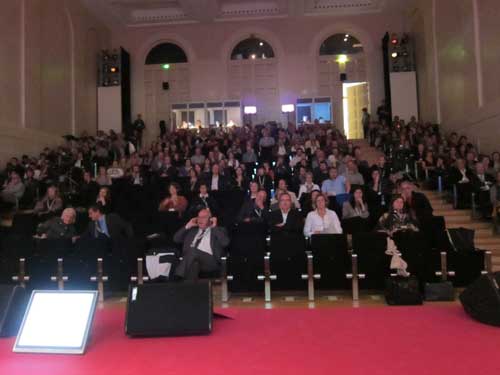
I spoke about “Gardening the City: Networking Small Green Spaces” at the Jardins y Publics conference last week in Metz, France. The conference brings together world leaders in botanic gardens, garden design, local governments, and tourism. It is organized by Pascal Garbe and the Conseil Général of Moselle, with support from the European Union.
The conference exceeded my imagination in terms of discussing new publics for gardens: the disabled, children, seniors, and refugees. I appreciated the outward focus beyond the walls of the garden, and the attendees were very interested to hear about Tokyo street gardens and urban wildness.
One of the most interesting and discussed talks was by Fritz Haeg, who has turned American lawns into vegetable gardens and received much attention from contemporary art museums. I am interested to read his book about this project, called Edible Estates.
Other speakers included leaders of the Barcelona, Singapore, New York and Montreal botanic gardens, Scandinavian garden designers, nonprofit community organizers, health advocates, and promoters of private gardens. Attendees included local government officials and landscape design students from this interesting area along the French, German and Luxembourg border.
The conference was an amazing experience. Further highlights included visiting the Jardins Fruitiers de Laquenexy, and the Centre Pompidou-Metz. Metz itself is a charming town divided between a historic French city around a very steep cathedral, and a German city built around the train station.
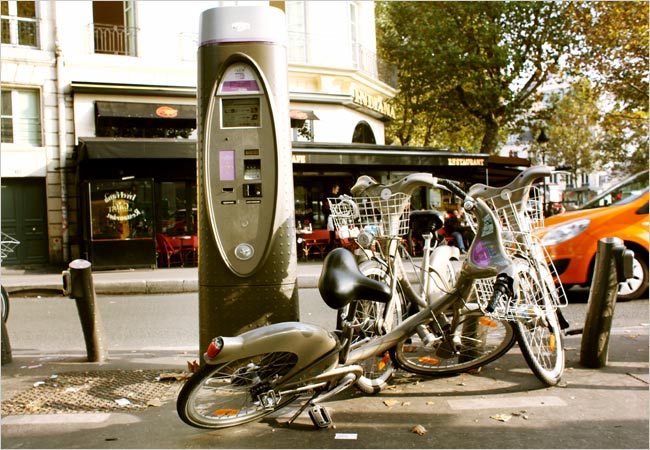
A recent New York Times story about vandalism of Paris’ visionary Velib bike-sharing program highlighted an enormous advantage that Tokyo has in creating great public spaces: the respect that citizens pay to shared space and to each other.
To mitigate climate change, reduce traffic and clean the city’s air, Paris created a remarkable bike sharing program, with over 20,000 bicycles available throughout Paris at a very low rental price. With 50,000 to 150,000 daily trips, this bike-sharing program created a real impact on how residents and tourists traversed the city. Since 2007, more than 80% of the sturdy bicycles have been stolen or vandalized beyond repair.
The New York Times quotes Parisian police and sociologists who blame the attacks on “resentful, angry or anarchic youth” in a “socially divide Paris.” Specific blame is given to suburban youth, the mostly poor immigrants who live in the outskirts of the city and view the bicycles as a symbol of urban privilege that they lack.
Compared to the extreme inequality in many global cities, Tokyo remains surprisingly safe and clean. This allows for some amazing new public spaces, from the wonderous Ginza Farm open to everyone and unguarded– disturbed in five months only by a raccoon hungry for one of its ducks (more on this later)– to the many common gardens and plants placed outside homes and shops.
Most Tokyo residents are unaware that their relative social harmony is unique. With public behavior the norm, there are unparalleled opportunities to create even more exciting new public spaces that revitalize human life connected to plants and wildlife. Public spaces open at night, habitats that require clean running water, valuable plants that require time and care to mature, the care that individuals and organizations invest in place-making are all more likely to be respected and allowed to thrive in Tokyo.
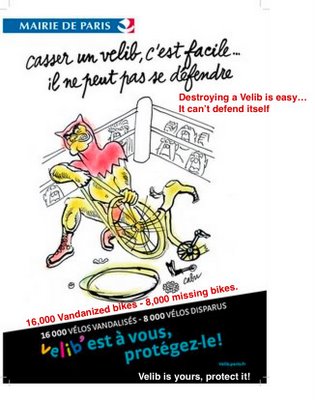
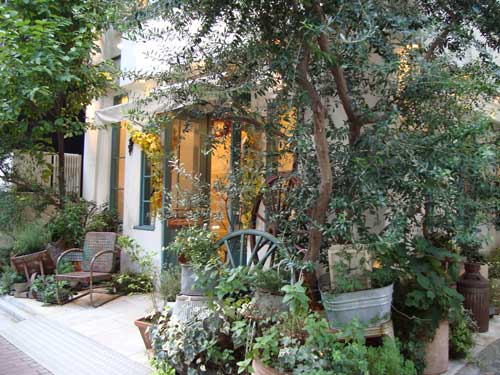
Walking in Tokyo always provides new discoveries. In Ginza, where global brands are housed in tall ultra-contemporary mid-rises, there are still small alleys and two story buildings. I was astounded to stumble upon this bakery housed in what seems the perfect simulation of the French countryside.
When Japanese set out to evoke a foreign scene, it is amazing how many details they add to create the perfect illusion. This bakery, Patisserie Qu’il fait bon, achieves its look with a simple two story structure with plentiful casement windows, a cobblestone driveway, and just slightly excessive exterior lighting. But perhaps even more effective is the landscaping: many layers of plants, all in pots, much like the humble gardens created by older ladies in countless residential streets. What makes this landscape at once bold and persuasive are the many layers, variety of colors that harmonize with the paint trim, and the assortment of metal and recycle wood plants with objects such as a rusted chair, a clock, some farm house wheels, and other bric-a-brac. I like how artfully “untamed” the landscape appears, despite being meticulously staged and styled.
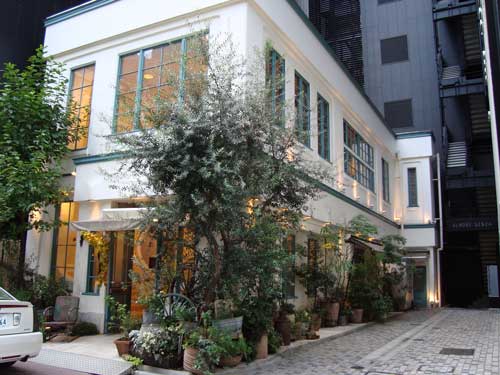
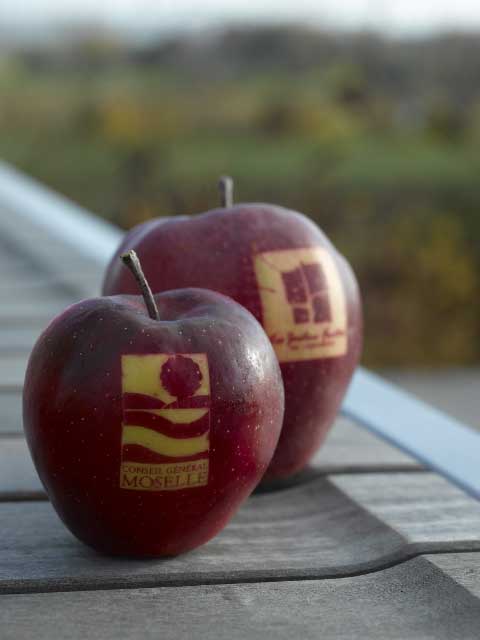
This week I was surprised to receive an invitation from Monsieur Pascal Garbe to speak about Tokyo Green Space at next year’s Gardens and Publics international conference in Metz, France. The conference is sponsored by the European Union and the Conseil Général de la Moselle.
Monsieur Garbe is the Director of Jardins Fruitiers de Laquenexy, a fruit tree garden that is over one hundred years old. Laquenexy has an apple exchange program with Hirosaki, Aomori, Japan’s largest apple producer in the North. Laquenexy is one of the few European growers skilled at “printing” messages on apples (as seen above). There is a great post that explains how it is done on the UK’s Royal Horticultural Society’s blog and Monsieur Garbe’s role in sharing this technique. Monsieur Garbe is also involved in a regional tourist cooperation network of gardens and horticultural producers spanning Frances’ Moselle department and neighboring provinces in Luxembourg and Germany.
A past speaker at the Jardins sans Limites conference is noted Japanese landscape designer and monk Shunmyo Masuno (枡野俊明) of Kenkoh-ji temple. I am humbled to present this research amidst leading garden designers, botanic garden directors, horticultural leaders, journalists and writers, and government officials.